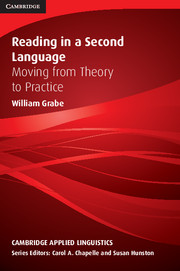Book contents
- Frontmatter
- Contents
- Series editors' preface
- Preface
- I FOUNDATIONS OF READING
- Chapter 1 The nature of reading: Defining reading
- Chapter 2 How reading works: The building blocks of fluency and comprehension
- Chapter 3 How reading works: Comprehension processes
- Chapter 4 Cognitive issues in reading
- Chapter 5 Models and more models of reading: Explaining reading
- II PATTERNS OF VARIATION IN READING
- III DEVELOPING READING COMPREHENSION ABILITIES
- IV EXPANDING READING COMPREHENSION SKILLS
- References
- Author Index
- Subject Index
Chapter 5 - Models and more models of reading: Explaining reading
from I - FOUNDATIONS OF READING
Published online by Cambridge University Press: 05 August 2012
- Frontmatter
- Contents
- Series editors' preface
- Preface
- I FOUNDATIONS OF READING
- Chapter 1 The nature of reading: Defining reading
- Chapter 2 How reading works: The building blocks of fluency and comprehension
- Chapter 3 How reading works: Comprehension processes
- Chapter 4 Cognitive issues in reading
- Chapter 5 Models and more models of reading: Explaining reading
- II PATTERNS OF VARIATION IN READING
- III DEVELOPING READING COMPREHENSION ABILITIES
- IV EXPANDING READING COMPREHENSION SKILLS
- References
- Author Index
- Subject Index
Summary
The term model refers specifically to a representation of the psychological processes that comprise a component or set of components involved in human text comprehension. (Goldman, Golden, & van den Broek, 2007: 27)
The previous chapters have explored many of the basic cognitive concepts and processes that underlie how we understand reading as well as the many major component processes involved in comprehension. A final goal for this part of the book is to explain how these concepts and component processes can be assembled into an understandable synthesis. These efforts at synthesis are most commonly accomplished by proposing models of reading. Models characterize theories of reading, providing ways to represent a theory or part of a theory; they explain what reading involves and, in more detailed versions, how reading works (Sadoski & Paivio, 2007). Most commonly, they are created from a body of research findings that can be synthesized to help explain the nature of reading abilities or of some major component of reading. Models generally make further predictions about reading beyond accounting for existing research results, and these predictions can be verified and falsified. In this way, models organize a body of research findings, help give coherent explanation to some larger ability, and provide the foundation for additional research exploration.
There are general models of reading-comprehension abilities and also models of word recognition, models of syntactic processing, models of working memory, and models of inferencing. There are specific models based on empirical evidence and metaphorical models that make more abstract generalizations. In every case, the authors are looking to explain how reading, or certain essential subcomponents of reading, might work based on available evidence.
- Type
- Chapter
- Information
- Reading in a Second LanguageMoving from Theory to Practice, pp. 83 - 106Publisher: Cambridge University PressPrint publication year: 2008



